key FORD POLICE INTERCEPTOR UTILITY 2014 1.G Owner's Manual
[x] Cancel search | Manufacturer: FORD, Model Year: 2014, Model line: POLICE INTERCEPTOR UTILITY, Model: FORD POLICE INTERCEPTOR UTILITY 2014 1.GPages: 406, PDF Size: 6.86 MB
Page 148 of 406
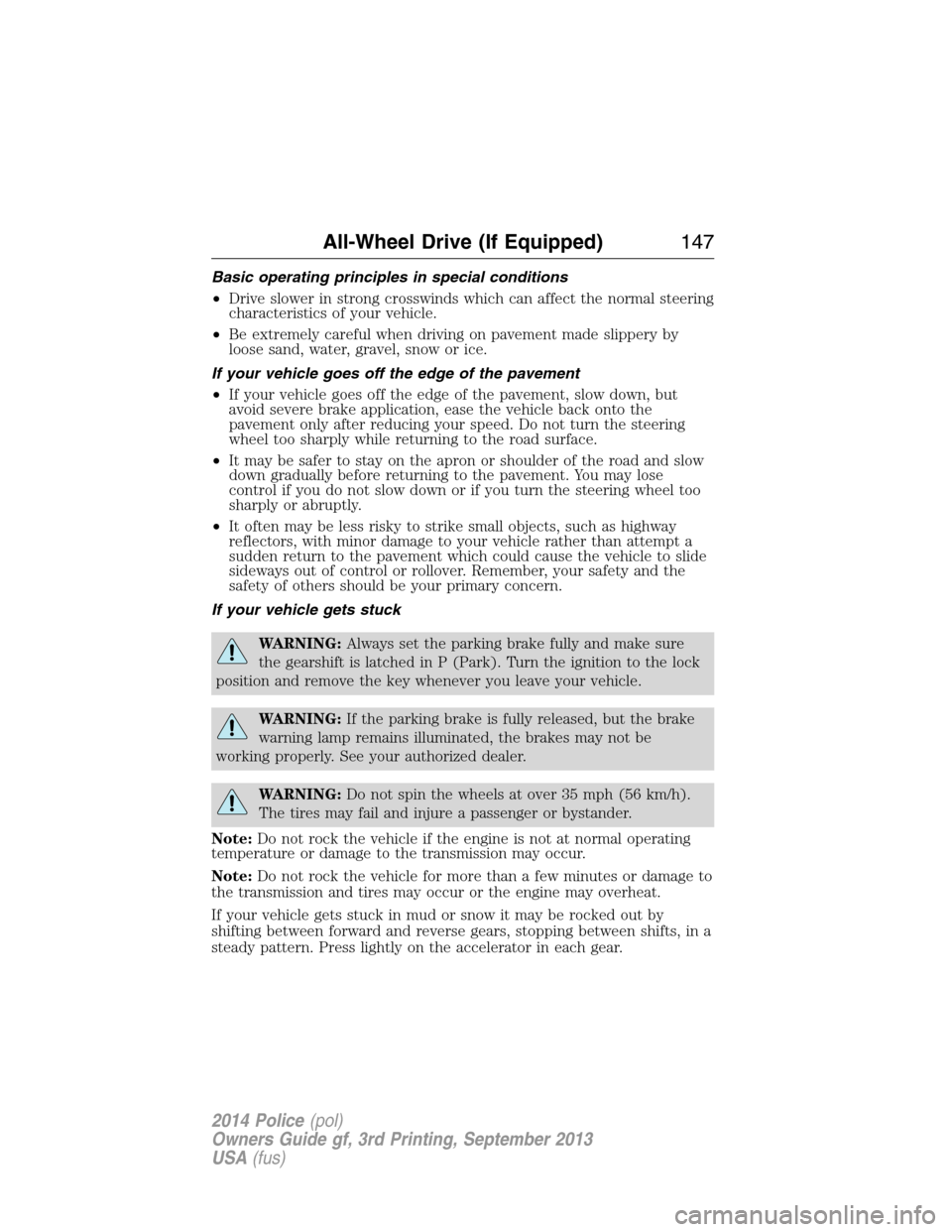
Basic operating principles in special conditions
•Drive slower in strong crosswinds which can affect the normal steering
characteristics of your vehicle.
•Be extremely careful when driving on pavement made slippery by
loose sand, water, gravel, snow or ice.
If your vehicle goes off the edge of the pavement
•If your vehicle goes off the edge of the pavement, slow down, but
avoid severe brake application, ease the vehicle back onto the
pavement only after reducing your speed. Do not turn the steering
wheel too sharply while returning to the road surface.
•It may be safer to stay on the apron or shoulder of the road and slow
down gradually before returning to the pavement. You may lose
control if you do not slow down or if you turn the steering wheel too
sharply or abruptly.
•It often may be less risky to strike small objects, such as highway
reflectors, with minor damage to your vehicle rather than attempt a
sudden return to the pavement which could cause the vehicle to slide
sideways out of control or rollover. Remember, your safety and the
safety of others should be your primary concern.
If your vehicle gets stuck
WARNING:Always set the parking brake fully and make sure
the gearshift is latched in P (Park). Turn the ignition to the lock
position and remove the key whenever you leave your vehicle.
WARNING:If the parking brake is fully released, but the brake
warning lamp remains illuminated, the brakes may not be
working properly. See your authorized dealer.
WARNING:Do not spin the wheels at over 35 mph (56 km/h).
The tires may fail and injure a passenger or bystander.
Note:Do not rock the vehicle if the engine is not at normal operating
temperature or damage to the transmission may occur.
Note:Do not rock the vehicle for more than a few minutes or damage to
the transmission and tires may occur or the engine may overheat.
If your vehicle gets stuck in mud or snow it may be rocked out by
shifting between forward and reverse gears, stopping between shifts, in a
steady pattern. Press lightly on the accelerator in each gear.
All-Wheel Drive (If Equipped)147
2014 Police(pol)
Owners Guide gf, 3rd Printing, September 2013
USA(fus)
Page 169 of 406
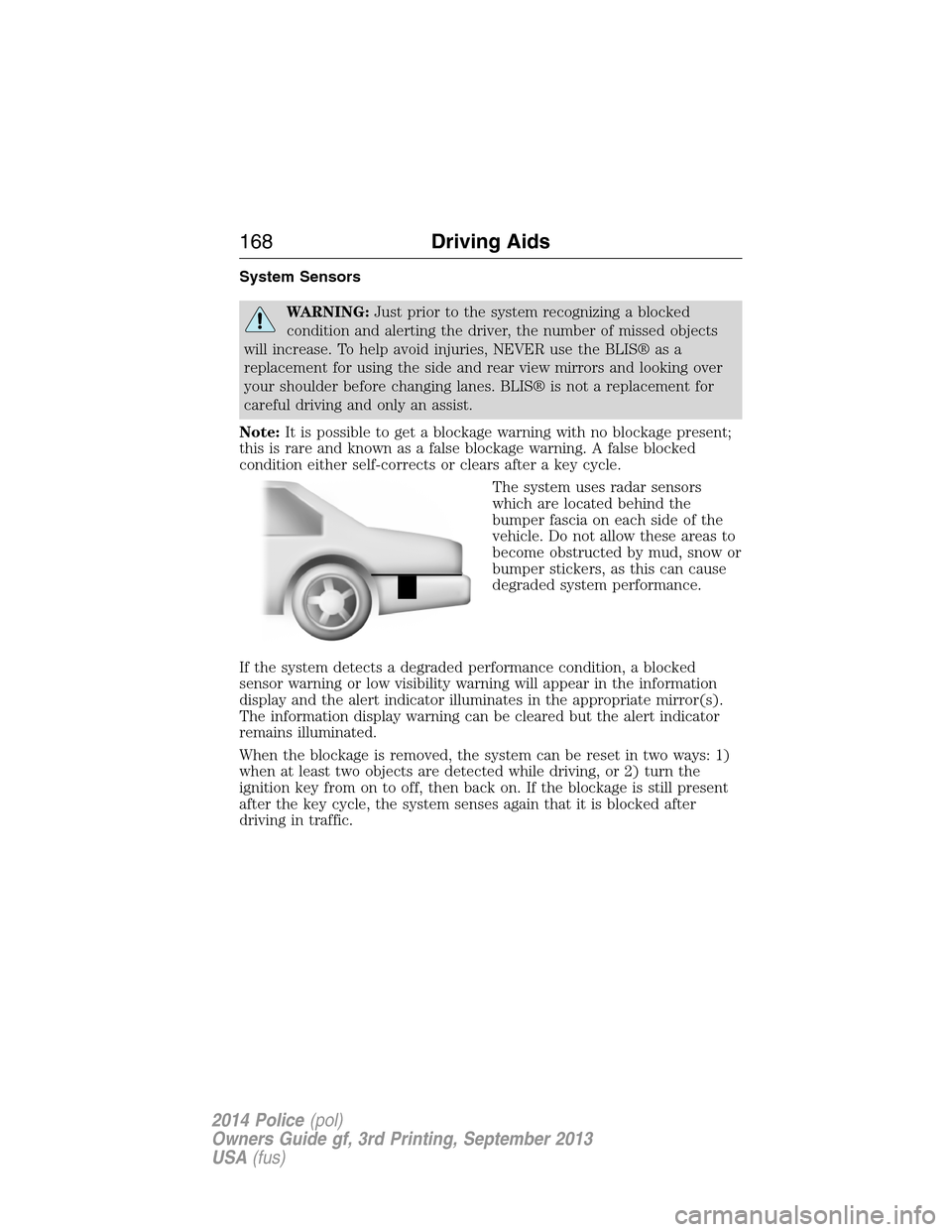
System Sensors
WARNING:Just prior to the system recognizing a blocked
condition and alerting the driver, the number of missed objects
will increase. To help avoid injuries, NEVER use the BLIS® as a
replacement for using the side and rear view mirrors and looking over
your shoulder before changing lanes. BLIS® is not a replacement for
careful driving and only an assist.
Note:It is possible to get a blockage warning with no blockage present;
this is rare and known as a false blockage warning. A false blocked
condition either self-corrects or clears after a key cycle.
The system uses radar sensors
which are located behind the
bumper fascia on each side of the
vehicle. Do not allow these areas to
become obstructed by mud, snow or
bumper stickers, as this can cause
degraded system performance.
If the system detects a degraded performance condition, a blocked
sensor warning or low visibility warning will appear in the information
display and the alert indicator illuminates in the appropriate mirror(s).
The information display warning can be cleared but the alert indicator
remains illuminated.
When the blockage is removed, the system can be reset in two ways: 1)
when at least two objects are detected while driving, or 2) turn the
ignition key from on to off, then back on. If the blockage is still present
after the key cycle, the system senses again that it is blocked after
driving in traffic.
168Driving Aids
2014 Police(pol)
Owners Guide gf, 3rd Printing, September 2013
USA(fus)
Page 173 of 406
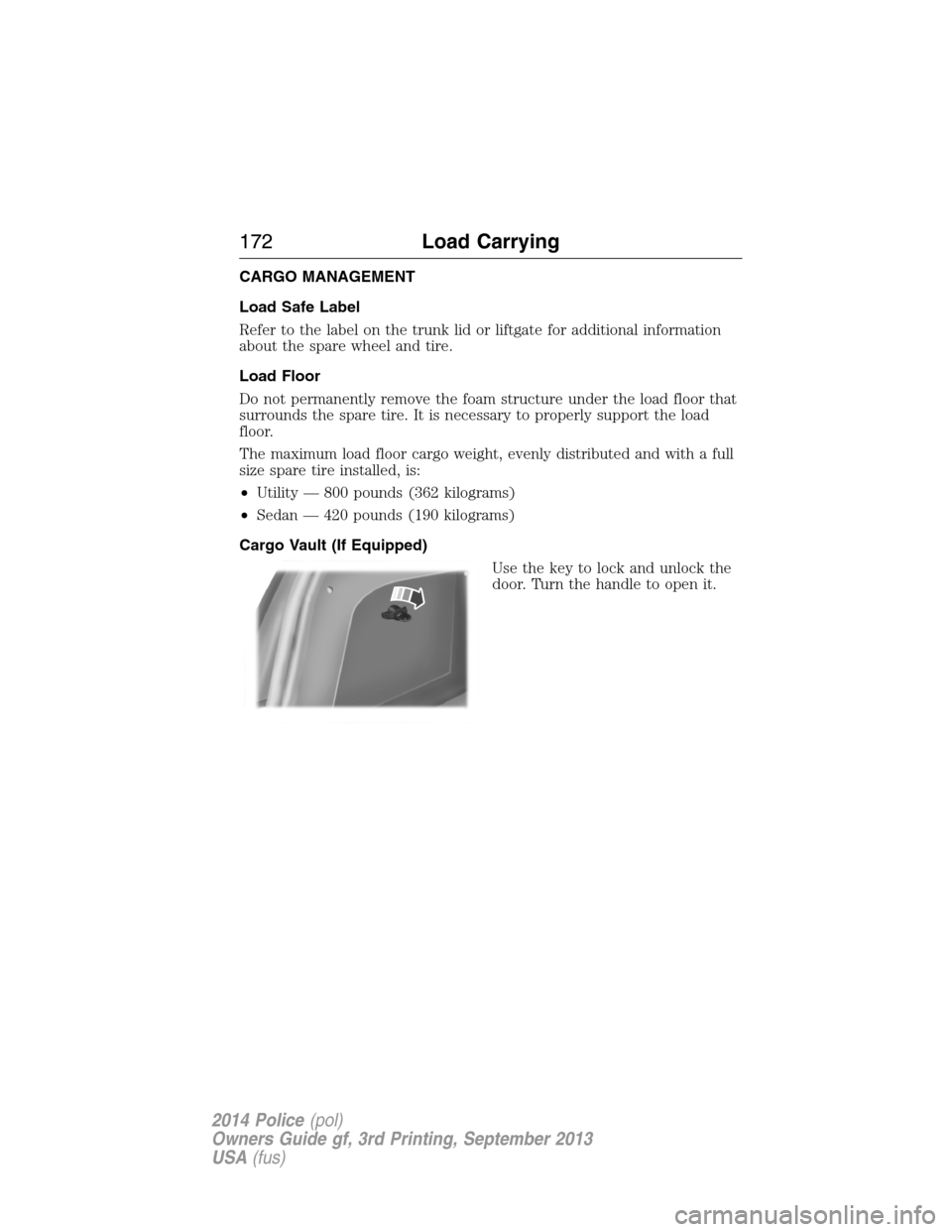
CARGO MANAGEMENT
Load Safe Label
Refer to the label on the trunk lid or liftgate for additional information
about the spare wheel and tire.
Load Floor
Do not permanently remove the foam structure under the load floor that
surrounds the spare tire. It is necessary to properly support the load
floor.
The maximum load floor cargo weight, evenly distributed and with a full
size spare tire installed, is:
•Utility — 800 pounds (362 kilograms)
•Sedan — 420 pounds (190 kilograms)
Cargo Vault (If Equipped)
Use the key to lock and unlock the
door. Turn the handle to open it.
172Load Carrying
2014 Police(pol)
Owners Guide gf, 3rd Printing, September 2013
USA(fus)
Page 174 of 406
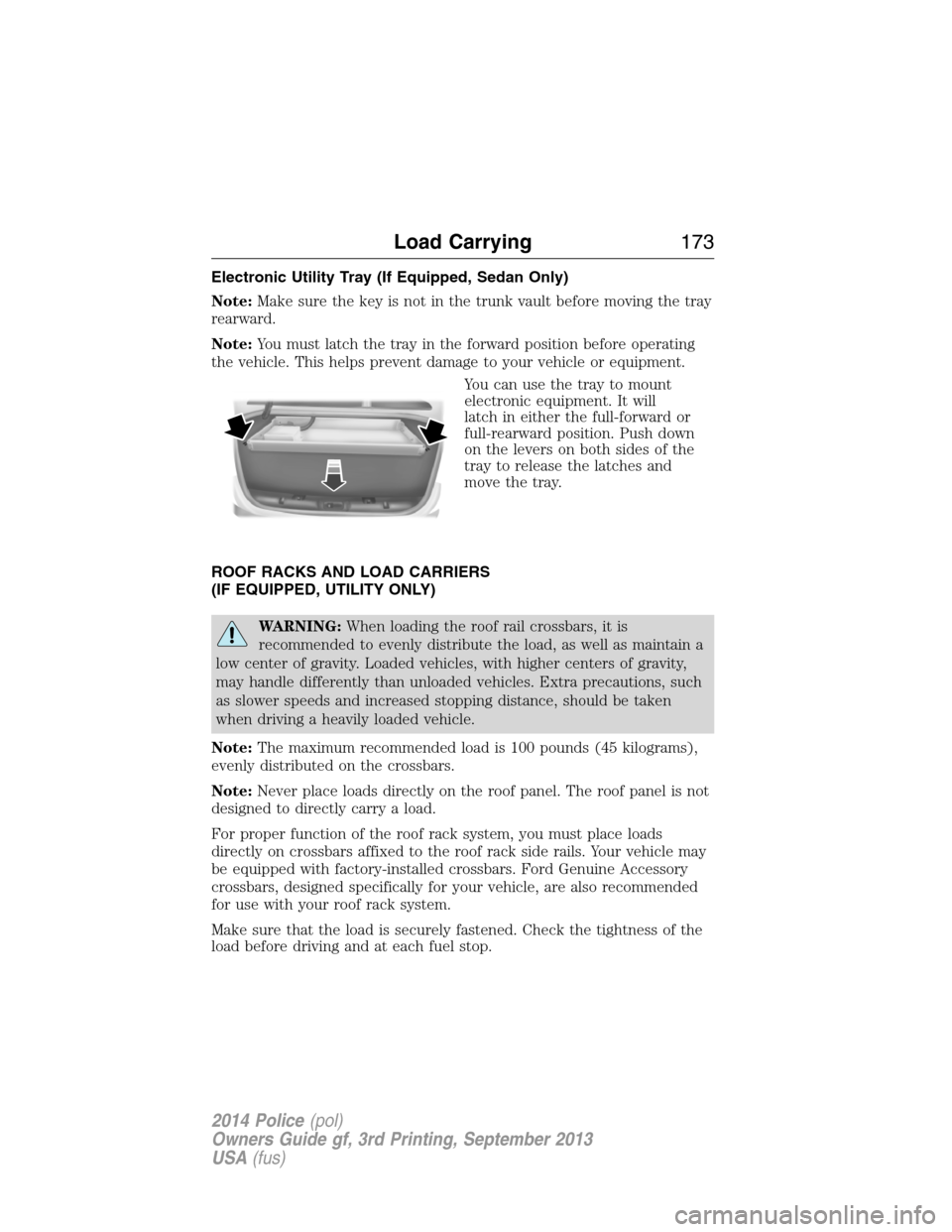
Electronic Utility Tray (If Equipped, Sedan Only)
Note:Make sure the key is not in the trunk vault before moving the tray
rearward.
Note:You must latch the tray in the forward position before operating
the vehicle. This helps prevent damage to your vehicle or equipment.
You can use the tray to mount
electronic equipment. It will
latch in either the full-forward or
full-rearward position. Push down
on the levers on both sides of the
tray to release the latches and
move the tray.
ROOF RACKS AND LOAD CARRIERS
(IF EQUIPPED, UTILITY ONLY)
WARNING:When loading the roof rail crossbars, it is
recommended to evenly distribute the load, as well as maintain a
low center of gravity. Loaded vehicles, with higher centers of gravity,
may handle differently than unloaded vehicles. Extra precautions, such
as slower speeds and increased stopping distance, should be taken
when driving a heavily loaded vehicle.
Note:The maximum recommended load is 100 pounds (45 kilograms),
evenly distributed on the crossbars.
Note:Never place loads directly on the roof panel. The roof panel is not
designed to directly carry a load.
For proper function of the roof rack system, you must place loads
directly on crossbars affixed to the roof rack side rails. Your vehicle may
be equipped with factory-installed crossbars. Ford Genuine Accessory
crossbars, designed specifically for your vehicle, are also recommended
for use with your roof rack system.
Make sure that the load is securely fastened. Check the tightness of the
load before driving and at each fuel stop.
Load Carrying173
2014 Police(pol)
Owners Guide gf, 3rd Printing, September 2013
USA(fus)
Page 194 of 406
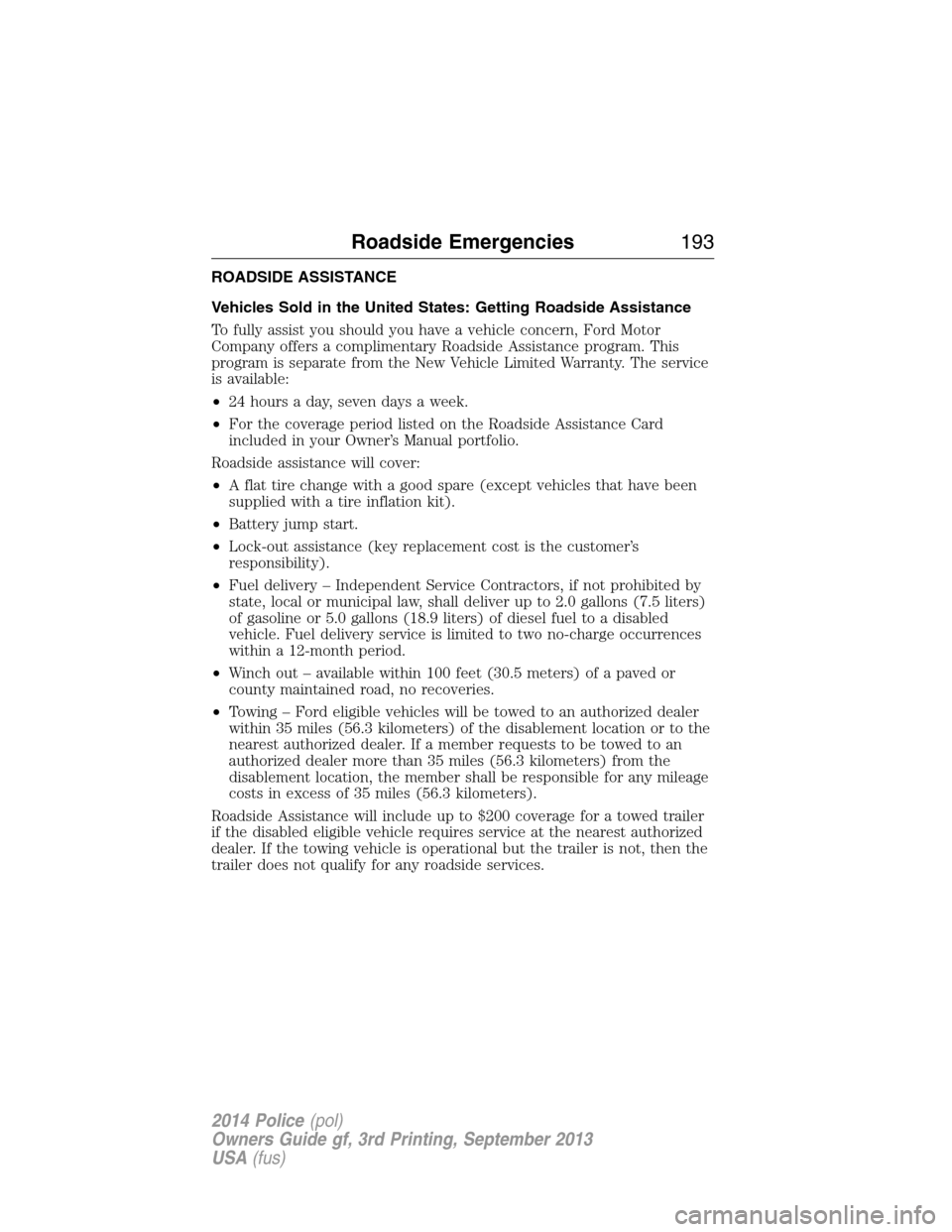
ROADSIDE ASSISTANCE
Vehicles Sold in the United States: Getting Roadside Assistance
To fully assist you should you have a vehicle concern, Ford Motor
Company offers a complimentary Roadside Assistance program. This
program is separate from the New Vehicle Limited Warranty. The service
is available:
•24 hours a day, seven days a week.
•For the coverage period listed on the Roadside Assistance Card
included in your Owner’s Manual portfolio.
Roadside assistance will cover:
•A flat tire change with a good spare (except vehicles that have been
supplied with a tire inflation kit).
•Battery jump start.
•Lock-out assistance (key replacement cost is the customer’s
responsibility).
•Fuel delivery – Independent Service Contractors, if not prohibited by
state, local or municipal law, shall deliver up to 2.0 gallons (7.5 liters)
of gasoline or 5.0 gallons (18.9 liters) of diesel fuel to a disabled
vehicle. Fuel delivery service is limited to two no-charge occurrences
within a 12-month period.
•Winch out – available within 100 feet (30.5 meters) of a paved or
county maintained road, no recoveries.
•Towing – Ford eligible vehicles will be towed to an authorized dealer
within 35 miles (56.3 kilometers) of the disablement location or to the
nearest authorized dealer. If a member requests to be towed to an
authorized dealer more than 35 miles (56.3 kilometers) from the
disablement location, the member shall be responsible for any mileage
costs in excess of 35 miles (56.3 kilometers).
Roadside Assistance will include up to $200 coverage for a towed trailer
if the disabled eligible vehicle requires service at the nearest authorized
dealer. If the towing vehicle is operational but the trailer is not, then the
trailer does not qualify for any roadside services.
Roadside Emergencies193
2014 Police(pol)
Owners Guide gf, 3rd Printing, September 2013
USA(fus)
Page 219 of 406
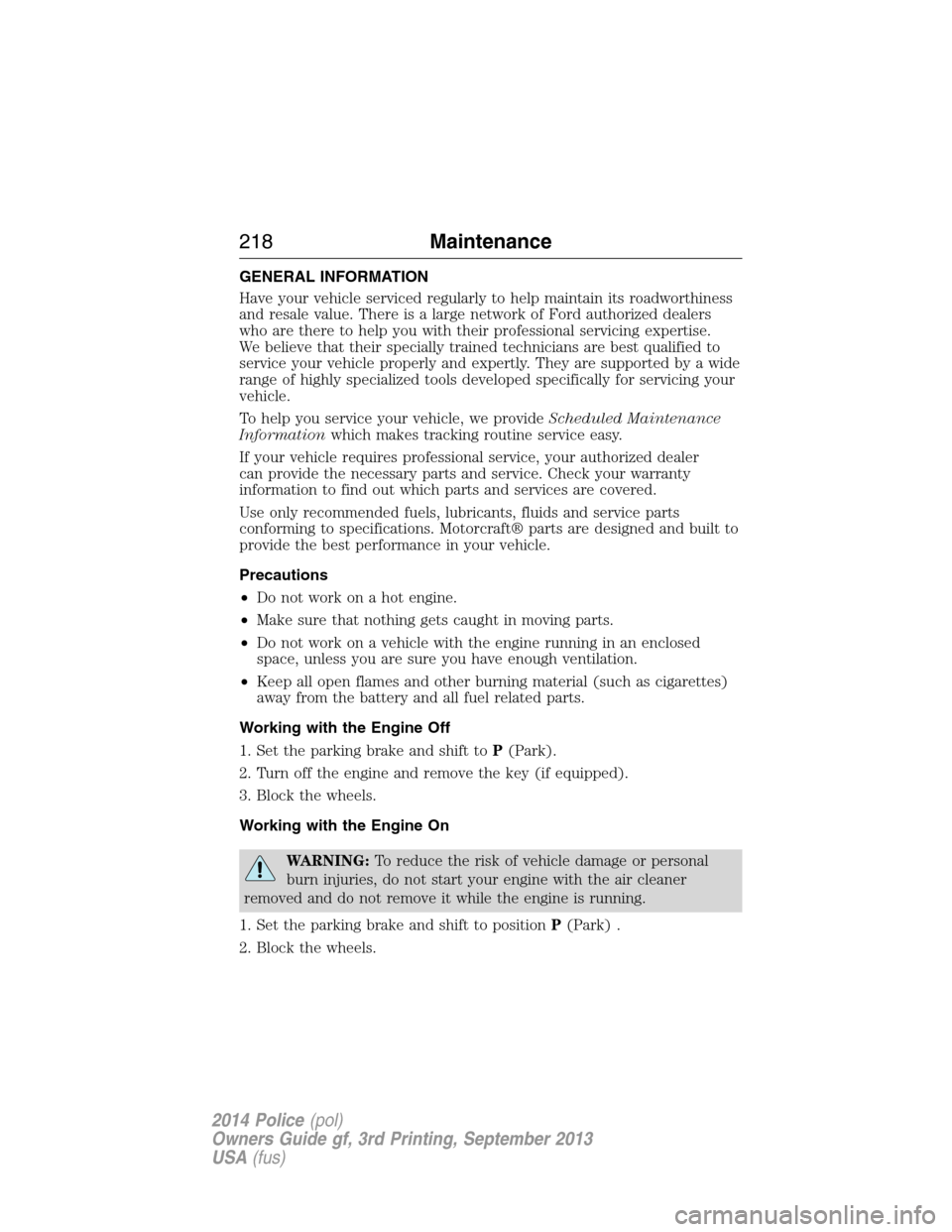
GENERAL INFORMATION
Have your vehicle serviced regularly to help maintain its roadworthiness
and resale value. There is a large network of Ford authorized dealers
who are there to help you with their professional servicing expertise.
We believe that their specially trained technicians are best qualified to
service your vehicle properly and expertly. They are supported by a wide
range of highly specialized tools developed specifically for servicing your
vehicle.
To help you service your vehicle, we provideScheduled Maintenance
Informationwhich makes tracking routine service easy.
If your vehicle requires professional service, your authorized dealer
can provide the necessary parts and service. Check your warranty
information to find out which parts and services are covered.
Use only recommended fuels, lubricants, fluids and service parts
conforming to specifications. Motorcraft® parts are designed and built to
provide the best performance in your vehicle.
Precautions
•Do not work on a hot engine.
•Make sure that nothing gets caught in moving parts.
•Do not work on a vehicle with the engine running in an enclosed
space, unless you are sure you have enough ventilation.
•Keep all open flames and other burning material (such as cigarettes)
away from the battery and all fuel related parts.
Working with the Engine Off
1. Set the parking brake and shift toP(Park).
2. Turn off the engine and remove the key (if equipped).
3. Block the wheels.
Working with the Engine On
WARNING:To reduce the risk of vehicle damage or personal
burn injuries, do not start your engine with the air cleaner
removed and do not remove it while the engine is running.
1. Set the parking brake and shift to positionP(Park) .
2. Block the wheels.
218Maintenance
2014 Police(pol)
Owners Guide gf, 3rd Printing, September 2013
USA(fus)
Page 288 of 406
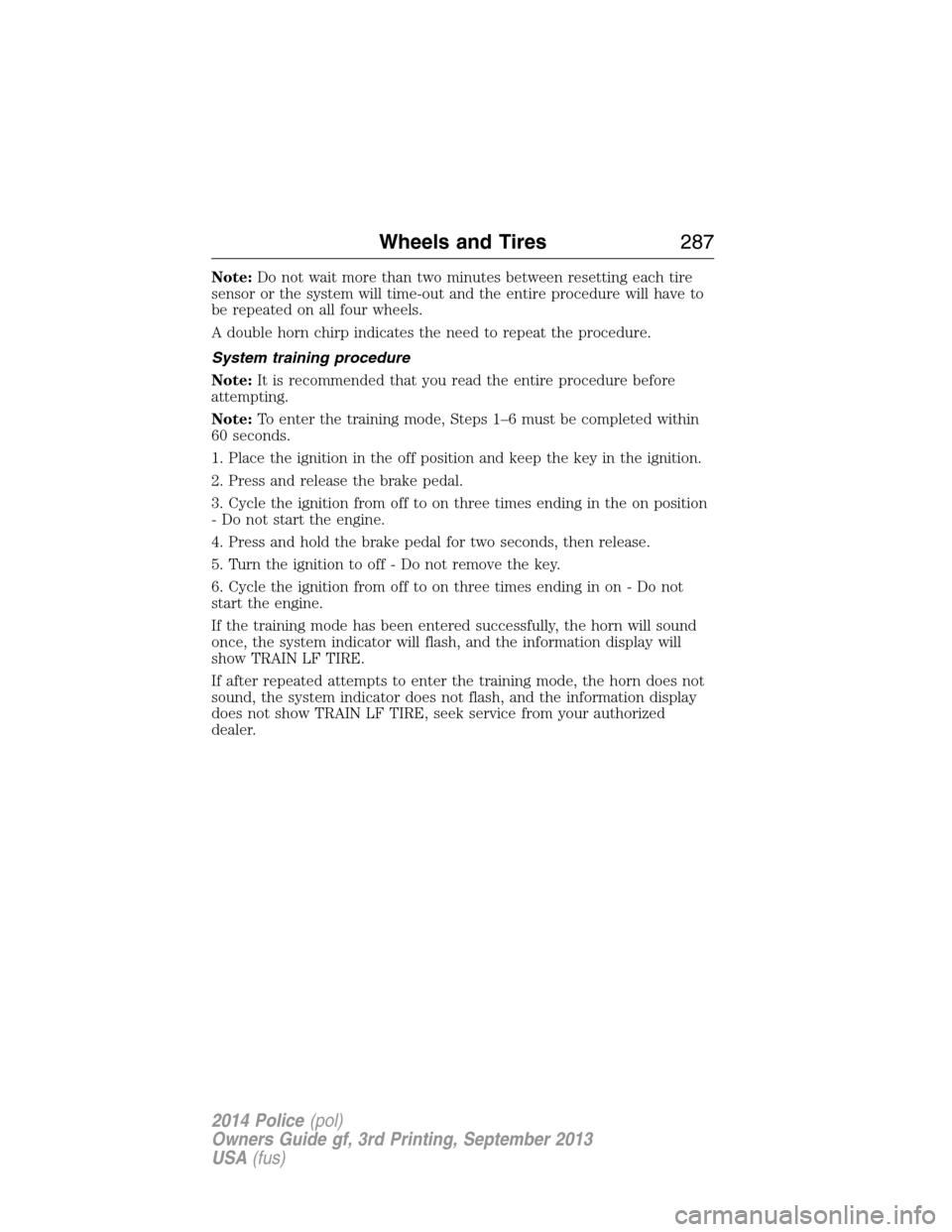
Note:Do not wait more than two minutes between resetting each tire
sensor or the system will time-out and the entire procedure will have to
be repeated on all four wheels.
A double horn chirp indicates the need to repeat the procedure.
System training procedure
Note:It is recommended that you read the entire procedure before
attempting.
Note:To enter the training mode, Steps 1–6 must be completed within
60 seconds.
1. Place the ignition in the off position and keep the key in the ignition.
2. Press and release the brake pedal.
3. Cycle the ignition from off to on three times ending in the on position
- Do not start the engine.
4. Press and hold the brake pedal for two seconds, then release.
5. Turn the ignition to off - Do not remove the key.
6. Cycle the ignition from off to on three times ending in on - Do not
start the engine.
If the training mode has been entered successfully, the horn will sound
once, the system indicator will flash, and the information display will
show TRAIN LF TIRE.
If after repeated attempts to enter the training mode, the horn does not
sound, the system indicator does not flash, and the information display
does not show TRAIN LF TIRE, seek service from your authorized
dealer.
Wheels and Tires287
2014 Police(pol)
Owners Guide gf, 3rd Printing, September 2013
USA(fus)
Page 403 of 406
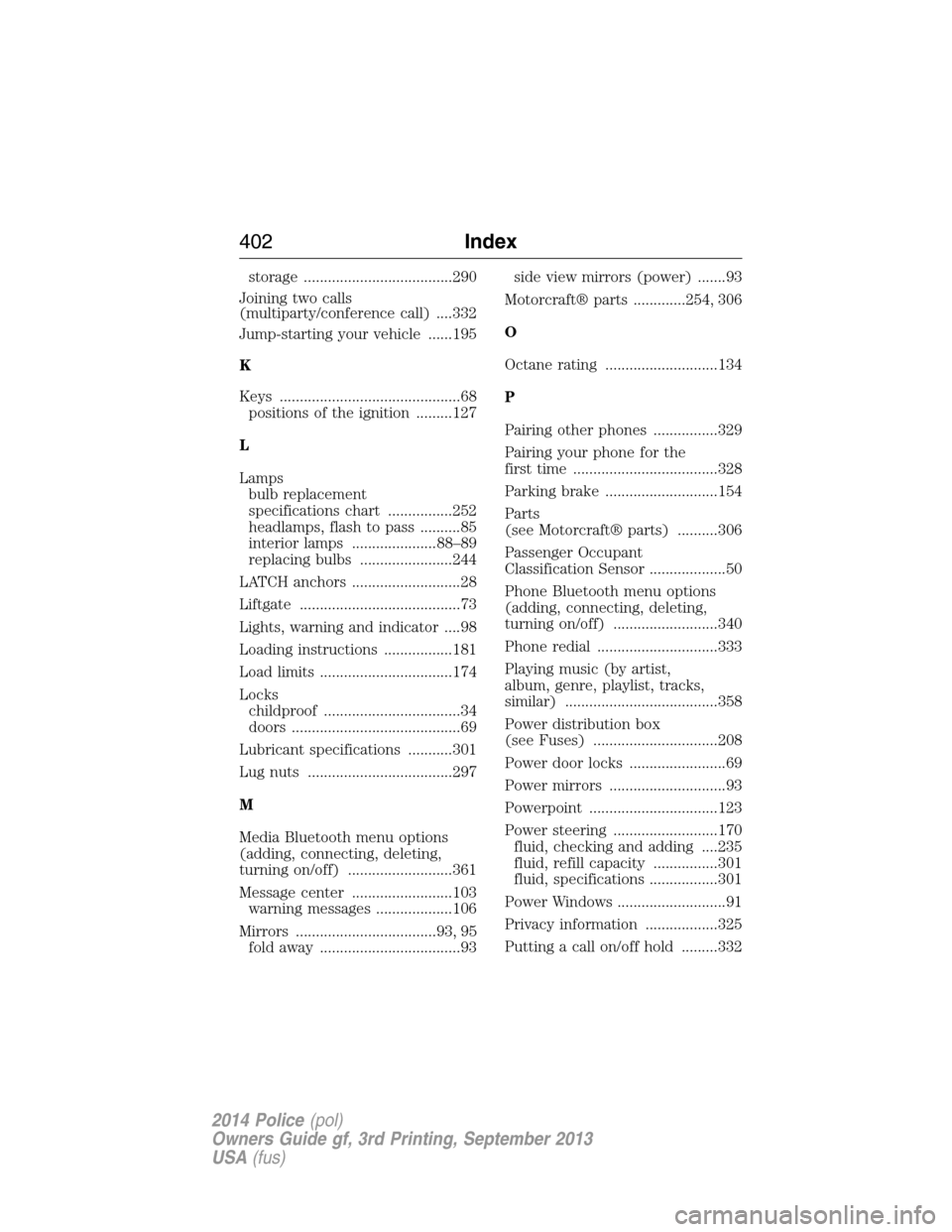
storage .....................................290
Joining two calls
(multiparty/conference call) ....332
Jump-starting your vehicle ......195
K
Keys .............................................68
positions of the ignition .........127
L
Lamps
bulb replacement
specifications chart ................252
headlamps, flash to pass ..........85
interior lamps .....................88–89
replacing bulbs .......................244
LATCH anchors ...........................28
Liftgate ........................................73
Lights, warning and indicator ....98
Loading instructions .................181
Load limits .................................174
Locks
childproof ..................................34
doors ..........................................69
Lubricant specifications ...........301
Lug nuts ....................................297
M
Media Bluetooth menu options
(adding, connecting, deleting,
turning on/off) ..........................361
Message center .........................103
warning messages ...................106
Mirrors ...................................93, 95
fold away ...................................93side view mirrors (power) .......93
Motorcraft® parts .............254, 306
O
Octane rating ............................134
P
Pairing other phones ................329
Pairing your phone for the
first time ....................................328
Parking brake ............................154
Parts
(see Motorcraft® parts) ..........306
Passenger Occupant
Classification Sensor ...................50
Phone Bluetooth menu options
(adding, connecting, deleting,
turning on/off) ..........................340
Phone redial ..............................333
Playing music (by artist,
album, genre, playlist, tracks,
similar) ......................................358
Power distribution box
(see Fuses) ...............................208
Power door locks ........................69
Power mirrors .............................93
Powerpoint ................................123
Power steering ..........................170
fluid, checking and adding ....235
fluid, refill capacity ................301
fluid, specifications .................301
Power Windows ...........................91
Privacy information ..................325
Putting a call on/off hold .........332
402Index
2014 Police(pol)
Owners Guide gf, 3rd Printing, September 2013
USA(fus)